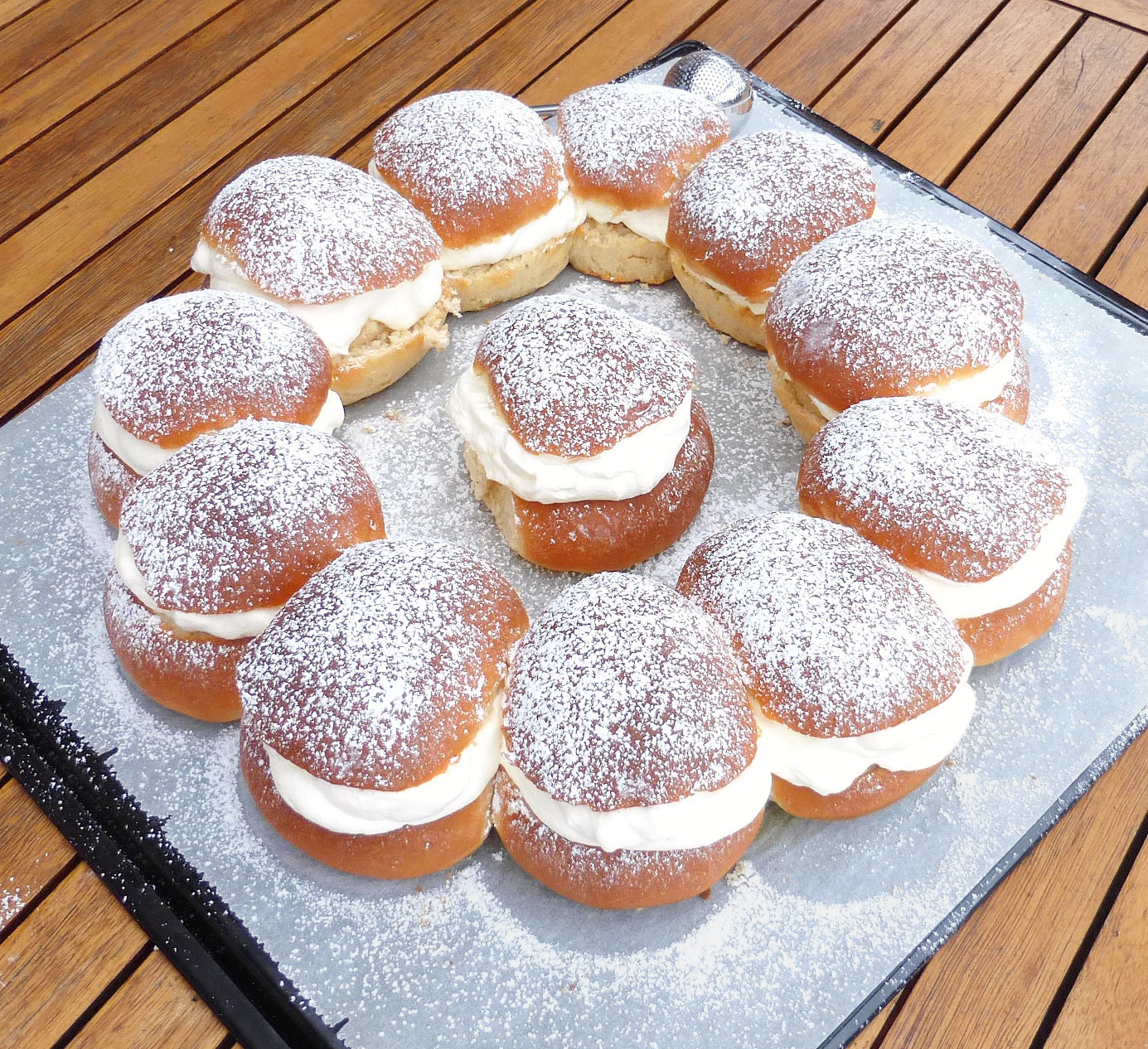Swedish Lent Cream Buns with Cardamom & Almond Paste
Swedish Lent cream buns (semlor) are dense, cardamom flavoured sweet buns. They are filled with luscious homemade almond paste and tonnes of whipped cream. The buns can be made with all-purpose or spelt flour.

Some of the links in this post could be affiliate links. Please read my disclosure and privacy policy for more information.
_________
Ah, Swedish semlor. One of my favourite things about living in here in Sweden. Seriously though, I do like a semla or two. I like them even better when they are homemade.
What are semlor?
Semlor are traditionally eaten on Shrove Tuesday. Or, pancake day as we know it in the UK. However, they are a bit like Easter eggs: eaten any time after Christmas.
Apparently, an average Swede will eat five store-bought Semlor, as well as home-baked, every year. Five? In a year? That’s outrageous. Ahem. I’ve eaten four of them since yesterday. For testing purposes, of course.
Swedish semlor are fairly dense buns usually made with regular plain (all purpose) flour. However, as this is The Spelt Kitchen, I’ve made them with both regular and spelt flour. The buns are mildly flavoured with cardamom and are slightly sweet.
After baking, a little hole is dug inside each bun. Inside this goes the mandelmassa, which is an almond paste. Mandelmassa is similar to marzipan, but the almond content is higher. It’s widely available in the shops here, but is so quick to make. Like most things, it tastes way better than any shop-bought variety.
The buns are then sandwiched together with oodles of whipped cream. De-licious.
A twist on authentic semlor
This year, I went a little fancy and made a ring of Swedish semlor. Each bun attached to the next, making them a delicious play on pull-apart bread. However, this was more for my own gratification. I achieve great pleasure when doing something a little different. This way of presenting them is not authentic, so feel free just to keep them as individual buns. Note: when on their own they are much rounder. Being part of a circle means they are slightly more elongated.
The measurements below made 12 big semlor. Thisis probably only necessary if you are entertaining and have many mouths to feed. I wasn’t kidding about eating four in the space of 24 hours. If you are only feeding your family, halve the recipe and just make six.
Because they are fairly dense, they are best eaten within a few hours of making them. At a stretch they will last until the next day (kept in the fridge in an airtight container).
Other Swedish spelt recipes
Sweden is responsible for some delicious culinary creations, and here are some of my favourites:
- How to make a classic kladdkaka
- Caramel and apple smulpaj
- Swedish rye seed bread
- Swedish apple cake
- White chocolate and saffron cranberry braid
- Swedish chocolate cookies
Swedish Semlor (Lent Cream Buns with Cardamom & Almond Paste)
Ingredients
Dough:
- 75g (⅓ cup) butter
- 300ml (1¼ cups) milk
- 50g (1¾ oz) fresh yeast (see note 1)
- 1 egg
- 55g (¼ cup) sugar
- 1 teaspoon cardamom powder
- 400-500g (4-5 cups) spelt flour (see note 2)
Mandelmassa (almond paste):
- 100g (3½ oz) almonds (see note 3)
- 100g (½ cup) sugar
- 1 tablespoon milk
Additional ingredients:
- 500ml (2 cups) whipping cream (36% fat)
- Icing / powdered sugar (for dusting)
Instructions
Dough:
- Add the butter and milk in a small pan and heat just under the butter is starting to melt (the mixture should be no warmer than a lukewarm temperature).
- Remove from the heat and crumble in the fresh yeast. Leave for around 5-10 minutes so that yeast can activate.
- Beat the egg and add to the liquid, stirring to combine.
- In a large bowl add around 300g of flour, cardamom and sugar and stir to combine.
- Pour in the liquid and mix with a spoon until the dough comes together. Add more flour as required. The secret to soft bread is not to add too much flour, and semlor are no exception.
- Pour the dough out on to a floured surface. It should have pulled together but still be very sticky. Gradually add a little flour at a time until you can knead the dough, only adding more when it becomes too sticky to handle.
- Knead for around 6 minutes and then place the dough back in the bowl, cover with a tea-towel and leave to rise in a warm place for around 45-60 minutes.
- Knead again for about a minute until the dough is nice and smooth (add a little more flour if necessary but again, keep to a bare minimum).
- Line a large baking tray with grease-proof paper (you might need two trays if they are small) and divide the dough into 12 balls of similar size.
- If you are going for a joined circle effect like mine, place the balls in close proximity (although not touching) and they will join together as they rise and bake.
- If you want the simpler method, place each ball a good space apart on the baking tray(s). Cover and leave once more to rise for a further 30 minutes. Pre-heat the oven to 200°C (392ºF).
- Bake for around 15-20 minutes until the tops are very golden and the bottoms sound hollow when tapped.
- Leave them to cool under a tea-towel and when completely cold, prepare as below, or store in an airtight container until you are ready to fill them (semlor dry out pretty quickly).
Almond paste:
- First, blanch the almonds in hot water for around 60 seconds and then remove the skins (see note 3).
- Place the almonds in a food processor and blitz until they are fine, then add the sugar.
- Continue to process until a warm paste comes together (around 10 minutes).
- Add one to two tablespoons of milk until a spreadable but very thick paste forms.
Assembly:
- If you've followed my method and have a semlor "ring", very gently take the tops off with serrated knife. You probably won't manage to keep the tops as one whole piece (I didn't), but as long as the bottom bit hold together, it doesn't matter. If you have individual buns, just cut the top off each one.
- Spread the almond paste equally over the bottom part of the semlor.
- Whip the cream until it is stiff and then spread (or pipe) over the almond paste.
- Top with the other half the buns and then liberally sprinkle with icing sugar. Serve and enjoy!
Notes
- If you don't have access to fresh yeast, use 14g (4½ teaspoons) of dried yeast. In Sweden we have something called dried yeast. It is used both in warm liquid to proof and also added directly to flour. I am aware that the US has two options for dried yeast, and I believe instant yeast is the most similar to our dried yeast.
- You can use spelt or regular flour for this recipe (just use the same amount).
- If your almonds are already blanched, skip this step.





1 thought on “Swedish Lent Cream Buns with Cardamom & Almond Paste”